Bathroom Water Damage: Causes, Solutions, and Coverage
Bathrooms, by nature, are the most water-exposed areas in our homes. It’s no wonder they’re prime spots for potential water damage. Recognizing, addressing, and understanding coverage options for bathroom water damage can save homeowners significant stress and money.
Where Does Bathroom Water Damage Typically Occur?
- Showers and Tubs: The constant exposure to water makes showers and tubs susceptible. Faulty seals or cracked tiles can lead to water seeping behind walls and beneath floors.
- Sinks and Countertops: Overflowing sinks or leaky faucets can cause bathroom vanity water damage to countertops and cabinets, and if unchecked, the water can spread to floors and walls.
- Toilets: Overflow or leaks can lead to water damage not just on the bathroom floor but also in the ceiling of rooms below if situated on an upper floor.
- Vent Fans and Windows: Insufficient ventilation can lead to condensation build-up, fostering mold and mildew growth.
- Pipes: Hidden behind walls and under floors, leaky pipes can quietly cause significant damage if they go unnoticed.
Who to Call When You Spot Water Damage in Your Bathroom?
- Professional Water Damage Restoration Company: Specializing in water extraction and damage repair, these experts can mitigate the damage, dry out the affected areas, and guide on further repairs.
- Plumber: If the cause of the water damage is related to a plumbing issue, calling a plumber is crucial to fix the root of the problem.
- Mold Remediation Specialist: In cases where water damage leads to mold growth, professionals can ensure all mold is safely and effectively removed.
- Insurance Company: As soon as damage is noticed, inform your homeowner’s insurance to understand your coverage and begin the claims process.
Types of Water Damage and Their Coverage
There are three categories of water damage based on the source of water:
- Clean Water: This water comes from rain or leaky pipes. While it might not be harmful to touch, it can still cause property damage. Insurance typically covers this type of damage if it’s reported promptly.
- Gray Water: Slightly contaminated water from appliances, toilets, showers, and sinks falls into this category. While it poses a slight risk of illness upon contact, it’s often included in standard homeowners’ policies but conditions may apply.
- Black Water: The most contaminated and harmful, black water originates from sewers or floodwaters and can pose severe health risks. Most standard insurance policies don’t cover damage from black water unless you have specific flood insurance.
Understanding Your Coverage
Every insurance policy differs, but here are general rules to remember regarding bathroom water damage:
- Sudden and Accidental Damage: If the water damage was unexpected, like a bursting pipe, your policy likely covers it.
- Neglect: If damage results from neglect or lack of maintenance, insurance probably won’t cover it. For instance, if you ignored a leaky sink for months and it led to damage, you might be footing the bill.
- Gradual Damage: This refers to damage occurring over time, such as mold from a consistently leaking toilet. Most insurance policies do not cover gradual damage.
- Additional Coverage: For those living in flood-prone areas, considering additional flood insurance is wise. Standard policies might not cover water damage from natural disasters.
Five Prevention Tips to Reduce the Chances of Bathroom Water Damage
- Regular Inspections: Periodically check your bathroom fixtures such as faucets, showers, and toilets for any signs of wear and tear or minor leaks. Addressing these early can prevent more significant problems down the line.
- Effective Ventilation: Ensure your bathroom has proper ventilation to minimize condensation. Using exhaust fans during and after showers or baths can significantly reduce moisture buildup, which can lead to mold and mildew.
- Seal and Caulk: Regularly inspect and replace any deteriorating seals or caulking around the bathtub, shower, sink, and toilet. This prevents water from seeping into places it shouldn’t like behind walls or under the flooring.
- Proper Drainage: Keep drains clear of hair and debris to prevent clogs and overflows. Consider using a drain guard and regularly cleaning out the drain to ensure water flows freely.
- Address Spills Promptly: If water splashes or spills outside of the tub or sink, clean it up immediately. Prolonged water exposure, even in small amounts, can damage flooring or seep into cracks, causing further damage.
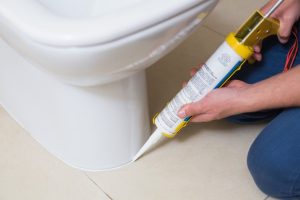
Frequently Asked Questions About Bathroom Water Damage
1. What are common signs of bathroom water damage?
Answer: Common signs include:
- Discolored or peeling paint on walls or ceiling
- Warped or swollen floorboards or tiles
- A musty or damp smell is consistently present
- Mold or mildew growth on walls, ceilings, or grout
- Soft or sagging spots on the walls or ceiling
2. How does bathroom water damage typically occur?
Answer: Water damage can result from various issues, such as:
- Leaking pipes behind walls or under the sink
- Overflowing toilets or bathtubs
- Poor ventilation leads to excessive condensation
- Leaky seals around the bathtub or shower
- Faulty caulking or grouting that allows water to seep behind tiles or fixtures
3. Can I handle water damage repair myself?
Answer: It depends on the extent and nature of the damage. Minor issues like re-caulking a tub or cleaning up a small overflow might be DIY tasks. However, if the damage has led to mold growth, affected electrical outlets, or compromised the structural integrity of the bathroom, it’s crucial to consult with a professional. They will have the necessary tools, knowledge, and expertise to ensure a safe and thorough repair.
4. How can I prevent water damage in the future?
Answer: Preventative measures include:
- Regularly checking and replacing old or worn-out caulking and grout
- Ensuring your bathroom is adequately ventilated to reduce condensation
- Frequently inspecting fixtures and connections for leaks
- Cleaning and maintaining drains to prevent blockages and overflows
- Addressing any signs of damage or wear promptly before they escalate
5. Will the homeowner’s insurance cover bathroom water damage?
Answer: In many cases, homeowner’s insurance will cover sudden and unexpected water damage, such as from a burst pipe. However, if the damage results from negligence or a lack of maintenance (like ignoring a slow leak for months), the insurance might not cover the repair costs. It’s essential to review your policy details and consult with your insurance provider to understand the specific coverages and exclusions.
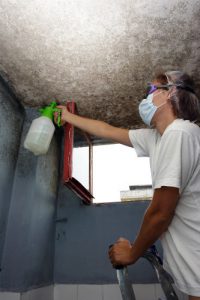
Bathroom Mold: A Stealthy Adversary
One of the most insidious results of bathroom water damage is mold growth. Given the damp environment of the bathroom, it’s a prime location for these spores to take root and spread.
Why is Mold in the Bathroom a Concern?
Health Implications: Mold spores can cause respiratory issues, especially for those with allergies, asthma, or compromised immune systems. Common symptoms include sneezing, skin rashes, eye irritation, and even more severe reactions in prolonged exposure cases.
Structural Damage: Over time, mold can weaken structural elements of your home, including wood framing or drywall. It’s not just a superficial problem; it can jeopardize your bathroom’s integrity.
Common Causes and Areas of Mold Growth in Bathrooms
- Poor Ventilation: Bathrooms without proper ventilation trap moisture, creating an ideal environment for mold.
- Leaky Fixtures: Slow leaks from faucets, showerheads, or pipes increase the bathroom’s moisture content.
- Damp Materials: Wet towels or rugs can foster mold growth if they don’t dry properly.
- Grout Lines and Caulking: These areas, especially in showers, are common spots for mold because they frequently come into contact with water.
Prevention and Remediation
- Regular Cleaning: Frequently clean your bathroom using mold-resistant products. Don’t forget less noticeable areas, like behind the toilet or under the sink.
- Ventilation: Ensure your bathroom has a functioning exhaust fan. It’s essential to run it during your shower and for 20-30 minutes afterward. If your bathroom doesn’t have a fan, cracking a window can help.
- Replace Caulking: Over time, caulk can break down, providing tiny spaces for mold to grow. Regularly inspect and replace it as needed.
- Dehumidifiers: These can be particularly helpful in larger bathrooms or in especially humid climates to reduce moisture content.
- Seek Professionals: If you notice significant mold growth, it might be time to call in a mold remediation expert. They can not only remove the existing mold but can also provide tips and solutions to prevent future growth.
Call Gold Coast Flood Restorations for Problems with Bathroom Mold or Water Damage
Bathroom water damage, though frequent, is manageable with periodic inspections and immediate rectifications. Having a keen eye for potential problem areas and a clear understanding of your insurance coverage can stave off long-term issues. Ensuring a mold-free environment, both for the home’s longevity and its occupants’ health, remains paramount. Regular maintenance, combined with expert guidance when needed, ensures a dry, safe, and comfortable bathroom space.

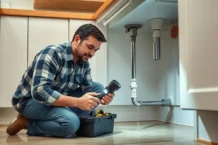
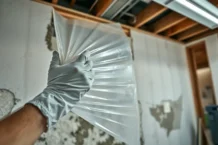
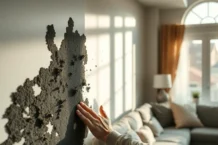

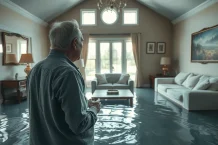
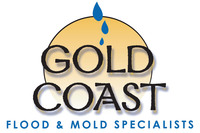


Follow Us!